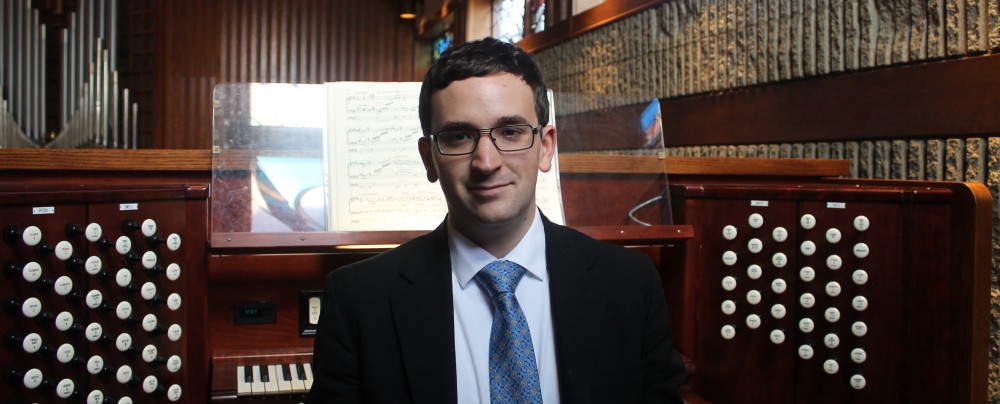For my first post here, I am including a brief essay I wrote for the graduate organ lit seminar on 20th c. music about one of Ligeti’s two seminal organ etudes, Coulée. This is so short that it’s not really publishable, so I think the blog forum is especially appropriate. There will be several more of these posted soon.
The concept of Étude for Ligeti clearly involves an exploration of compositional and formal method as much as technical study for the instrument involved. In the two organ etudes of 1967-9, Ligeti clearly challenges established norms, upending and redefining the answers to a number of musical questions. These questions include those posed by the very titles of the works: what is harmony (Harmonies)? What does it mean to be flowing (Coulée)? Of course, the irony of the harmony in Harmonies is that it is totally ‘denatured’ by the organ’s limited wind, creating an entirely new type of harmony. In ‘denaturing’ the organ by limiting its wind supply Ligeti raises another question, namely; what is the organ? What does it do and what does it play? Both of these pieces raise major questions like these and provide some possible answers in their brief durations.
As compared to the instrument-redefining Harmonies, Coulée may seem relatively straightforward in comparison. The main effect created by the instrument itself is the sense of stasis and non-movement created by the constantly shifting metrical subunits and expanding and contracting pitches from G#/A-flat. Of course this seems to contradict the meaning of flowing, and yet does not. This dialectical relationship between assumed and actual meaning lies behind both etudes.
I will argue that Ligeti explores another important dialectical pole in Coulée: how can a piece be both strictly formally constructed and yet sound continuous and unarticulated? In his article “Interval and Form in Ligeti’s Continuum and Coulée” (Perspectives of New Music 31[1], Winter 1993), Michael Hicks describes the continuing sense of imbalance, the “sense of disequilibrium” and the little sense of “direction” in Coulée (Hicks 186). Yet at the same time, in an excellent diagram (Hicks 182), he is able to show how the contour of the pitch material neatly divides the work into three somewhat contrasting and relatively easily identifiable sections.
Given Ligeti’s Bartòk-inherited and demonstrable preoccupation with symmetry and the Golden Section, as identified by both Hicks and Michael A. Roig-Francoli in his article “Harmonic and Formal Processes in Ligeti’s Net-Structure Compositions” (Music Theory Spectrum 17[2], Autumn 1995), the evident lack of symmetry and the “near continuous elision” (Hicks 181) in Coulée is all the more notable.
Despite the obvious imbalance in terms of pitch contour (without deeper level theoretical investigation this is immediately evident by looking at the precipitous ascent in pitch space with which the piece ends), the sense of elision created by the relentless mecchanico surface, and the sense of stasis created by the perpetual presence of A-flat/G#, a formal investigation conducted from approaches other than Hicks’ pitch-based one reveals that some paramaters of Coulée exhibit such simple clarity of form that the piece might be deemed classical.
There are two primary means that Ligeti uses to create some sense of classical binary form, despite the tripartite divisions in pitch content and overall seamlessness of the etude. The first of these means is through addition and movement of the pedal line. The beginning and end of the piece is without pedal entirely. Interestingly, Hicks briefly notes that the pedal’s movement to low C (and introduction of 32’ and 16’ registers) occurs in measure 39 while the pedal is tacet again beginning in measure 145, 39 measures from the end of the piece. This creates one type of symmetry, and the feeling of return is heightened in a more general sense by the pedal’s silence at the end of the piece.
After the pedal entry in m. 14, the first half of the piece is neatly divided into 3 sections of almost exactly equal length (mm. 14-39, 40-66, 66-92) punctuated by changes in pedal registration.
The halfway point of the piece is neatly established by the alignment of both hands into two-note octave groupings on A-flat. This protracted unison sonority not only marks the climax of the expanding pitch contour wedge, but also marks a return to two-note rhythmic subunits. These subunits are the second principal way in which Ligeti establishes some sense of binary form in Coulée. In the first half of the piece the rhythmic groupings first expand from two notes to five notes (mm. 36 and 44—RH and LH respectively), and then contract to two notes (mm. 64 and 91—LH and RH respectively). In the second half of the piece, the groupings again expand to five notes (mm. 141 and 172—RH and LH respectively). Of course this expansion takes somewhat longer in the second half and occurs somewhat differently, however this longer time span is balanced by the swiftness with which the rhythmic subunits abruptly contract in measures 160-181 (when the left hand returns to three note groupings). I believe that both the pitch changes and the changes in rhythmic groupings may occur in one or more complex, pre-determined patterns, perhaps even a pattern that might be expressed mathematically. The detailed study necessary in order to verify this theory, however, is beyond the scope of this writing.
Although Ligeti exploits some compositional parameters in order to create an intentional sense of imbalance and asymmetry, control of other parameters creates at least two types of symmetry and an overall sense of form audible to the listener even on first hearing. This intentional juxtaposition of both form-clarifying and form-obscuring elements fits in well with the dialectical play so evident in Ligeti’s organ études.
